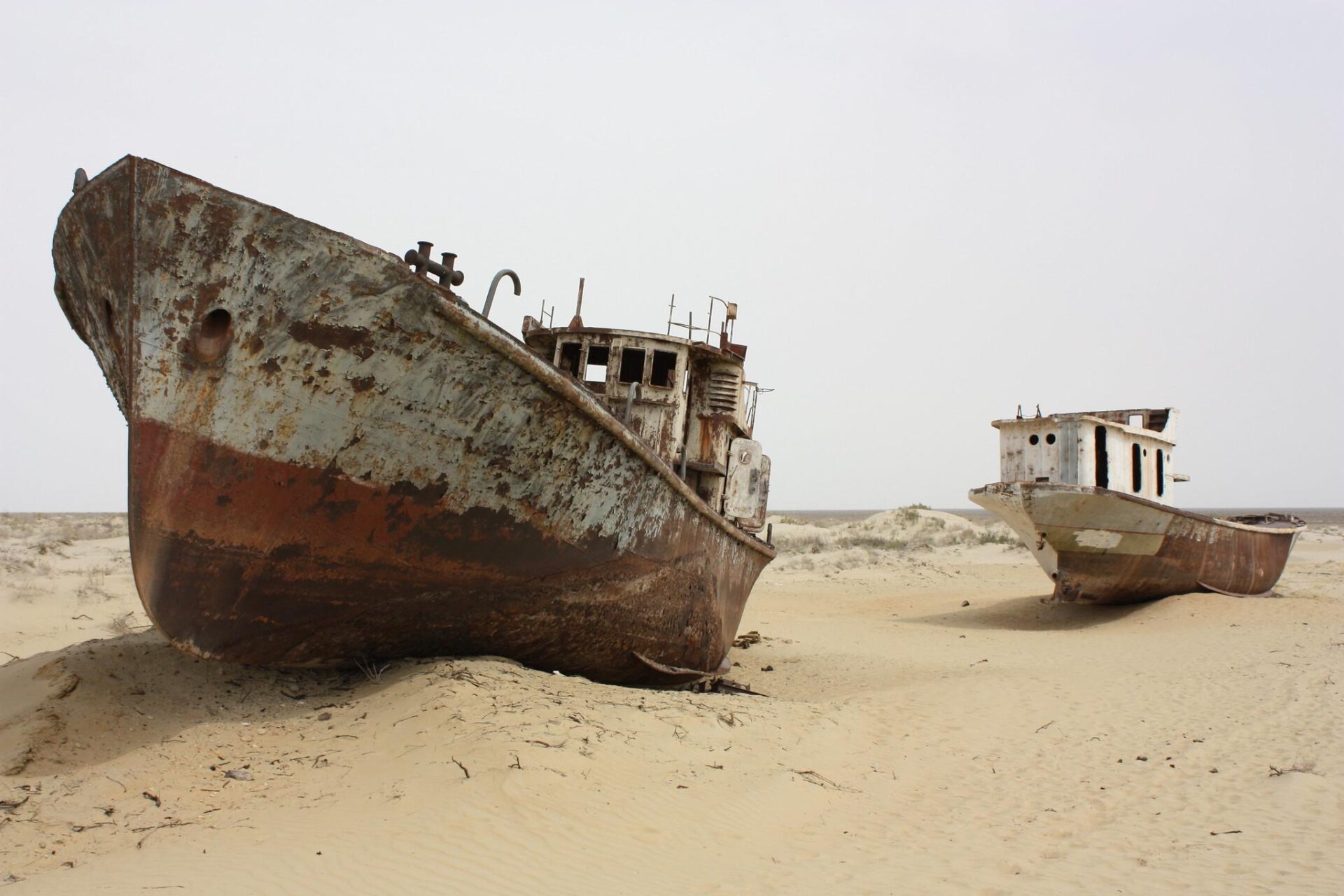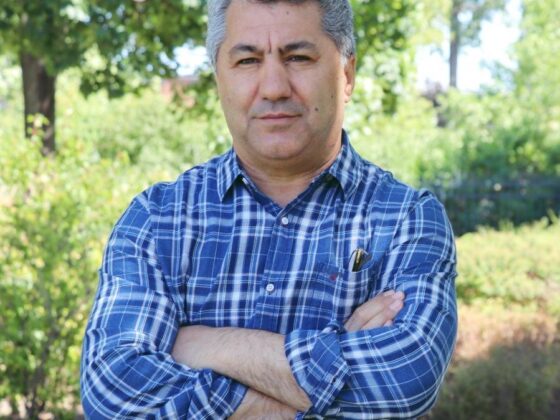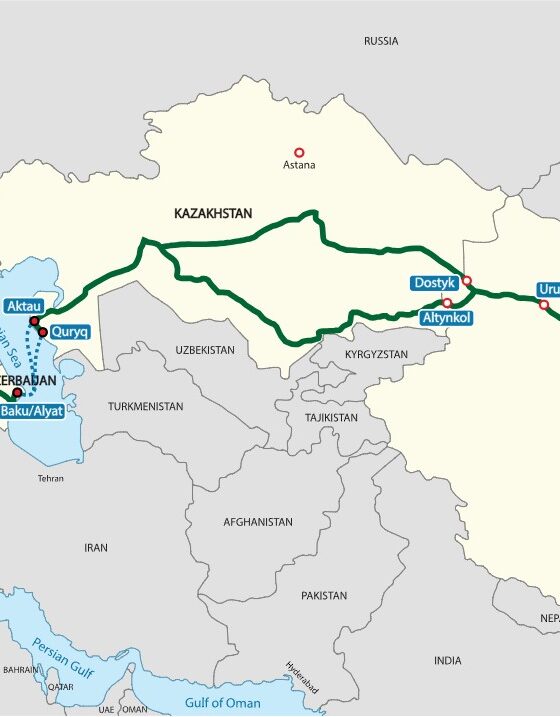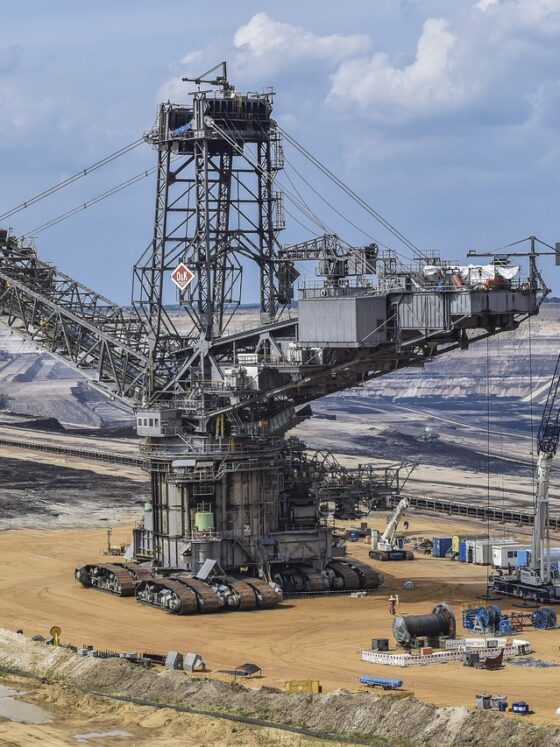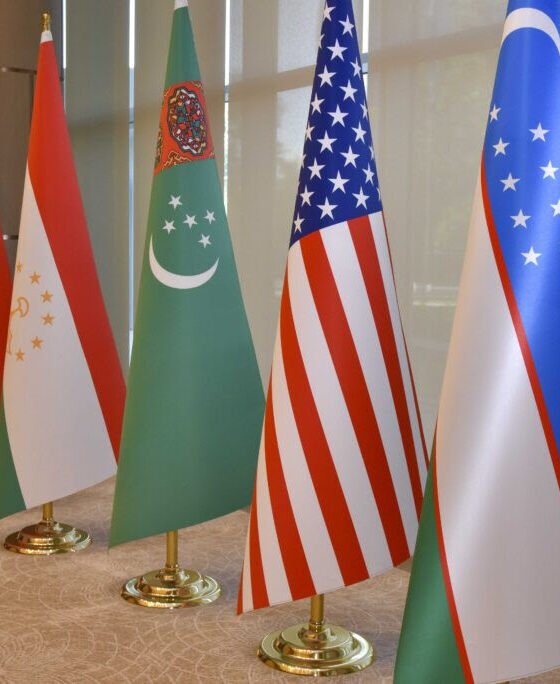
By Wilder Alejandro Sanchez
Wilder Alejandro Sanchez is an analyst who covers geopolitical, trade, and defense issues in the post-Soviet world and the Western Hemisphere. He has analyzed Kazakhstan’s foreign policy for several years and is currently working on a book chapter about the country’s economic diversification. His analyses have appeared in numerous peer-reviewed journals, including Small Wars and Insurgencies, Defence Studies, the Polar Journal, the Journal of Slavic Military Studies, European Security, Studies in Conflict and Terrorism, and Perspectivas. His most recent book chapter is a co-authored analysis of separatism in Moldova.
The Republic of Kazakhstan is facing two major water-related environmental challenges: salvaging what is left of the Aral Sea, which the country shares with Uzbekistan, and protecting Lake Balkhash, where Kazakhstan, as a downstream nation, has been affected by the water policies of its neighbor, the People’s Republic of China. The country also intents to capitalizing on its vast natural diversity to promote its eco-tourism industry as part of a wider economic diversification strategy to become one of the 30 most developed nations by 2050.
Environmental protection is not easy. It requires innovative thinking, diplomatic finesse, and the assistance of partners and allies. From the other side of the globe, the United States stands out as an important ally of Nur-Sultan on environmental protection, as this is one of U.S. President Joe Biden’s key priorities—as highlighted by a new U.S.-sponsored project for responsible water management in Central Asia. Looking to the future, Washington and Nur-Sultan should continue working together to preserve Kazakhstan’s environment, as protecting the Central Asian nation’s bodies of water and the “Green Steppe” will have positive consequences for the environment, as well as for socioeconomic and human development.
President Biden and Central Asia: A Foreign Policy in the Making
Having been in office only a few months, and with the COVID-19 pandemic still raging in the United States and across the world, the Biden Administration has yet to release a foreign policy strategy for Central Asia. This is hardly surprising: traditionally, discussions in Washington D.C. about this region have been limited to general analyses of Russian and Chinese influence or security issues related to terrorism and Afghanistan.
Visits to the region by senior U.S. policymakers are rare (Afghanistan notwithstanding), though they do occur. Then-Vice President Richard Cheney visited Kazakhstan in 2006, while then-Vice President Biden went to Mongolia in 2011. More recently, in 2015, Secretary of State John Kerry memorably toured all five Central Asian states; five years later, in 2020, Secretary of State Mike Pompeo traveled to Kazakhstan and Uzbekistan.
While Pompeo did meet with senior policymakers in both countries and even participated in a meeting with all five of his counterparts from the region under the C5+1 format (the five Central Asian states and the US), the visit was overshadowed by his criticism of China for its persecution of the predominantly Muslim Uyghur minority in Xinjiang province, also known as East Turkestan, in Western China, which Washington has labeled a genocide. Thus, little materialized in terms of bilateral initiatives and cooperation.
With regard to broader, medium-term strategies, the former Trump administration released a blueprint for strengthening ties between the US and Central Asia—The United States Strategy for Central Asia 2019-2025: Advancing Sovereignty and Economic Prosperity—but its effects have been negligible. One major problem was timing: as the strategy was released in February 2020, the Trump administration had less than a year in office to implement it. The emergence of the COVID-19 pandemic also prevented the strategy from really taking shape.
This US strategy for Central Asia does not mention climate change or environmental protection, though the document does advise the United States “to emphasize cooperation in those areas where it has a comparative advantage, [and also] foster adherence to international standards, including environmental safeguards.”[1] The strategy adds that “C5+1 projects are being implemented across Central Asia with over $34 million from the United States Government in the areas of security, economic connectivity, and environment.”[2] In other words, environmental protection is not given particular importance; rather, it is mushed together with other issues and mentioned in a very generic manner.
As for bilateral ties between Washington and Nur-Sultan, relations are generally cordial and amicable. In 2018, a high-profile meeting was held in Washington between then-Presidents Donald Trump and Nursultan Nazarbayev. In 2019, bilateral trade reached $2 billion, a small figure on the scale of the United States’ other trading partners but one that nevertheless makes Kazakhstan Washington’s largest trading partner in Central Asia (for comparison, U.S.-Uzbek trade that year only reached $540 million). As the next section will explain, environmental cooperation is an area where the two governments can cooperate further.
Washington’s Renewed Green Priorities and Central Asia
On April 1, 2021, the United States Agency for International Development (USAID) launched a new, five-year project in Kazakhstan called “USAID Water and Vulnerable Environment.” This project aims to strengthen “regional cooperation between the five countries of Central Asia and Afghanistan on the management of shared water resources and mitigate environmental risks in the Syr Darya and Amu Darya river basins.”[3]
Water management is an area where the Agency has an active presence in the Central Asian nation, since “USAID has also worked with Kazakhstani institutions to build their capacity and train emerging regional leaders in water resource management.”[4] Moreover, USAID has reportedly facilitated engagement on water issues between communities along the border between Kazakhstan and the Kyrgyz Republic.
It is quite noteworthy that one of the first Central Asia-related initiatives announced by the Biden Administration relates to water management and environmental protection. While this may be pure coincidence, the “USAID Water and Vulnerable Environment” project fits well with President Biden’s domestic and foreign policy priorities.
Similarly, the Council of the U.S.–Central Asia Trade and Investment Framework Agreement (TIFA) met in late March 2021 to discuss trade and investment. A U.S. diplomatic press release about the meeting notes that “the United States provided its counterparts with information on the key themes of the Biden Administration’s trade policy, including with respect to labor, environment and climate concerns.”[5] Once again, we see how the importance of environmental protection is highlighted by the Biden Administration in meetings with Central Asian policymakers.
Finally, in April 2021, President Biden hosted a virtual meeting of 40 world leaders to discuss how climate change is affecting the globe. Notably, no leader from the post-Soviet space attended, even though these regions are equally—if not more—affected by climate change. Yet if Central Asian governments wish to jump-start relations with the new White House, they must take environmental protection into consideration.
Kazakhstan Is Saving (What Remains of) the Aral Sea
In spite of its name, the Aral Sea, once one of the world’s largest lakes, is today comprised of lakes of varying sizes, the result of decades of Soviet and post-Soviet water management policies that diverted rivers to agricultural fields and irrigation programs. That being said, there is reason for hope: Kazakhstan has managed to protect what is left of the Aral Sea, which it shares with Uzbekistan.
Nur-Sultan has adopted more practical and responsible water management practices than prevailed during the Soviet era, with the result that water and life are slowly returning to Kazakhstan’s side of the Aral Sea. In 2001, the Kazakh Government
launched a vast rescue program for the Kazakh side of the Aral Sea, working in partnership with the World Bank. The program included construction of the 13-kilometer Kok-Aral dam, which divided the sea into two halves, north (Kazakh) and south (Uzbek). The rescue program also included development of the Syr Darya river banks to increase the volume of water being discharged into the northern part of the sea.[6]
Marine life is vibrant once again, allowing local coastal communities to engage in fishing for both sustenance and commerce.[7] Ideally, as Nur-Sultan and the Uzbek government engage in more connectivity and cooperation projects to promote trade and commerce, the two governments will work together to protect and recover the Uzbek side of the Aral Sea.
Out-of-the-box thinking is encouraged to figure out new methods of salvaging and restoring the Aral Sea region. One example is the Global Disruptive Tech Challenge 2021. During the event, which was organized by the World Bank and partner organizations, 24 entrepreneurs pitched “their ideas for restoring Central Asia’s Aral Sea to a panel of 20 experts. After three days of pitches, with each day dedicated to a specific theme, the winners were announced on the final day.”[8]
The winning proposals included such innovative ideas as beekeeping, female empowerment, a “geowall,” and a data collection tool.[9] The geowall proposal “centered on patented geowall technology built from sediment and other locally-sourced material such as cotton fibers and husks. The wall helps stabilize the land and acts as a barrier to prevent winds from blowing away toxic soil.”[10] The Aral Honey Gardens project envisions planting flowering trees to develop a beekeeping industry that creates jobs and income opportunities in parallel with reforestation.[11]
Downstream-Upstream Nations and the Future of Lake Balkhash
Environmental protection also has a geopolitical dimension, particularly where water management is concerned. Kazakhstan, like Turkmenistan and Uzbekistan, is a downstream country: it consumes the water that comes from the upstream nations of Kyrgyzstan and Tajikistan. In Uzbekistan, the water is used to grow cotton, a critical industry. For Kazakhstan, with its 19 million citizens, having reliable water flows from a variety of sources is vital to protecting the environment and meeting the needs of a population that is spread out across a large territory.
Much has been written about the “water wars” between Central Asian nations, but there is another participant to keep in mind: the People’s Republic of China. China has a particular role to play in the future of Kazakhstan’s Lake Balkhash, located in the southeastern part of the country.[12] This major water body is fed by rivers from Kyrgyzstan and Western China. As a 2007 Eurasianet report explains, “much of the water from the seven major rivers that replenish the lake originates in China and Kyrgyzstan. The most important of the rivers is the Ili.”[13] Hence, a major concern for Kazakhstan is that as the population of western China grows, Beijing will start diverting more water from the Ili River for domestic use, thereby drying up the lake.
Almost a decade and a half later, this problem persists, as highlighted by a 2021 article published in Water, which explained how water management policies along the Ili-Balkhash basin (IBB)—particularly in China, but also in Kazakhstan—are affecting the stability of the lake and jeopardizing its future.[14] “If the hydro-climatic regime of the Ili for 2020–2060 remains unchanged compared to the past 50 years, and agriculture continues to expand in China, future water supplies will become increasingly strained,” the authors argue.[15] The future certainly looks grim, as the Chinese government is developing its western regions, including Xinjiang, a process that is affecting the flow of the Ili River.
Kazakhstan and China have a strong but complicated relationship. Tens of thousands of ethnic Kazakhs, ethnic Kyrgyz, and other minorities have, like the Uyghurs, been sent to Chinese detention centers, putting a strain on Beijing’s relations with its neighbors. At the same time, Kazakhstan is a key component of China’s Belt and Road Initiative, as well as a key trading partner (particularly when it comes to supplying oil).[16] The survival of Lake Balkhash will be affected by the future of Nur-Sultan-Beijing relations, which are themselves heavily influenced by such factors as trade and the crisis in Xinjiang.
A Kazakh Objective: Eco-Tourism
Environmental protection is also important for national development. Kazakhstan aims to become one of the 30 most developed nations by 2050, an objective first delineated by then-President Nursultan Nazarbayev in a 2012 speech and which has been repeated in more recent government documents under President Kassym-Jomart Tokayev. One recent example is the government’s “National Development Plan Through 2025,” released in early 2021, which complements the “30 by 50” strategy.
To achieve this goal, Nur-Sultan is pursuing economic diversification in hopes of decreasing its reliance on oil and natural gas and developing other industries. Diversification includes developing the tourism industry by launching advertisement campaigns to attract international tourists and fostering eco-tourism.[17]
Specifically, the Kazakh government is looking to attract tourists to local green paradises like the Kolsay Lakes, located in Southern Kazakhstan by the Tian Shan mountains. The area—which includes Lower Kolsay Lake, Middle Kolsay Lake, Upper Kolsay Lake, and Lake Kaindy—is part of Kolsay Lakes National Park. The Kazakh Tourism Council has reportedly drafted a plan to promote eco-tourism by banning “mass gatherings, vehicle tours and overnight stays” and making the lakes part of a trekking route accessible only to hikers.[18] Eco- and wellness hotels are also planned.
Of course, since the globe continues to wrestle with the COVID-19 pandemic, it is debatable how many international tourists Kazakhstan will be able to attract in the foreseeable future. Nevertheless, Kazakh authorities are optimistic. Kazakh Minister of Ecology, Geology, and Natural Resources Magzum Mirzagaliyev has stated that “the preservation of unique natural sites is essential. We presented the concepts for ecological tourism development in the Ile-Alatau, Charyn National Parks, Altyn-Emel and Kolsay Lakes. Tourist routes and trails will be developed to prevent construction. We expect to open information centers, camping sites, and sites for caravans and motor-homes.”[19] The government’s medium-term goal is to attract investments worth 31 billion tenge ($72 million) by 2025 and over two million tourists to the country’s parks.
Since Kazakhstan has already adopted the “Very Nice!” catchphrase of Sacha Baron Cohen’s character Borat for its tourist campaign, the same catchphrase could be used for eco-tourism.[20]
The Potential Future of Washington-Nur-Sultan Environmental Cooperation
As Kazakhstan looks to continue its environmental protection policies, the question is what role the United States will play in this under the Biden administration.
There are diplomatic initiatives that can be undertaken. While Kazakhstan did not participate in the April summit in Washington on climate change, one option is that John Kerry, the U.S. president’s special representative for climate, could travel to Kazakhstan to discuss the USAID water-management project and the future of the Aral Sea and Lake Balkhash.
Additionally, the Kazakh government could host a summit of high-ranking environmental authorities from across Central Asia, with Kerry in attendance, under the banner of the C5+1 format. This would send a powerful message that Washington, Nur-Sultan, and the rest of the region share similar environmental policies and strategies. During the April 2021 virtual summit on climate change, President Biden noted that America is on the path to a “net-zero emissions economy by no later than 2050.”[21] Similarly, President Tokayev wants Kazakhstan to be carbon-neutral, although the goal is to achieve this by 2060, a decade later than the US.[22] A visit by Kerry to Nur-Sultan could plant the seeds for cooperation between the two governments, which would both help Kazakhstan in its quest for carbon-neutrality and pressure other regional governments to develop environmentally friendly policies.
Along similar lines, the next assistant secretary at the U.S. State Department’s Bureau of South and Central Asian Affairs—at the time of writing, Ambassador Donald Lu has been nominated for this position—must highlight in future meetings with officials and policymakers from this region the importance that Washington places on environmental protection and combating climate change.[23]
As for on-the-ground initiatives, agencies like USAID could provide funds for projects besides water management, such as helping fisheries in the Aral Sea and teaming up with Kazakh agencies to help Uzbekistan attempt to rescue its side of this water body. Similarly, USAID or another agency could co-fund, along with Nur-Sultan, studies to improve our understanding of how water policies are affecting Lake Balkhash and come up with potential remedies. USAID or U.S. universities could also team up with Kazakh universities and governmental agencies to study how climate change is impacting the Central Asian region.
Conclusions: The “Green Steppe” as a Foreign Policy Catalyst
The success of saving the Kazakh side of the Aral Sea demonstrates that some of the country’s environmental crises can be successfully addressed. What role can the United States play in Kazakhstan’s environmental efforts? The Biden White House has the opportunity to develop ties with Nur-Sultan in which the environment would enjoy a prominent position, a priority that was sorely lacking under the Trump Administration. USAID’s new water management program for Central Asia is a promising start, and other projects can also be undertaken to illuminate how climate change is affecting the country, identify how water policies are hurting Lake Balkhash in the long term, or cooperate to achieve carbon-neutrality.
To create a lasting relationship with meaningful impact between Kazakhstan and the United States, the two governments should look beyond conventional topics like defense, trade, and geopolitics. Environmental protection is an area that both countries should see as a priority and that can be used as a catalyst to increase cooperation and establish a long-term green partnership.
Photo by Arian Zwegers via Flickr
[1] “United States Strategy for Central Asia 2019-2025: Advancing Sovereignty and Economic Prosperity,” U.S. Department of State, February 5, 2020, https://www.state.gov/united-states-strategy-for-central-asia-2019-2025-advancing-sovereignty-and-economic-prosperity/, 3.
[2] Ibid., 6.
[3] “USAID Launches a New Regional Water and Environment Activity in Kazakhstan,” United States Embassy & Consulate in Kazakhstan, April 1, 2021, https://kz.usembassy.gov/usaid-launches-a-new-regional-water-and-environment-activity-in-kazakhstan/.
[4] “Energy and Environment,” United States Agency for International Development, February 16, 2021, https://www.usaid.gov/kazakhstan/energy-and-environment.
[5] “Joint Statement on the Results of the Council Meeting of the U.S.-Central Asia Trade and Investment Framework Agreement (TIFA),” United States Embassy & Consulate in Kazakhstan, April 2, 2021, https://kz.usembassy.gov/joint-statement-on-the-results-of-the-council-meeting-of-the-u-s-central-asia-trade-and-investment-framework-agreement-tifa/.
[6] Mike Coleman, “Saving the Steppe: Kazakhstan’s Environmental Protection Efforts,” Edge.kz, accessed April 17, 2021, https://www.edgekz.com/saving-steppe-kazakhstans-environmental-protection-efforts/.
[7] Dene-Hern Chen, “Once Written Off for Dead, the Aral Sea Is Now Full of Life,” National Geographic, March 16, 2018, https://www.nationalgeographic.com/science/article/north-aral-sea-restoration-fish-kazakhstan.
[8] Hugh Biggar, “Tech Stars Tackle Landscape Restoration in the Aral Sea in Innovative Competition,” Landscape News, April 12, 2021, https://news.globallandscapesforum.org/51332/tech-stars-tackle-landscape-restoration-in-the-aral-sea-in-innovative-competition/.
[9] “Disruptive Technology Event 2021, Winners,” Global Landscapes Forum, accessed April 17, 2021, https://events.globallandscapesforum.org/disruptive-technology/#winner.
[10] Biggar, “Tech Stars Tackle.”
[11] Marek Grzegorczyk, “Disruptive Tech Offers Solutions to Aral Sea Crisis,” Emerging Europe, April 13, 2021, https://emerging-europe.com/news/disruptive-tech-offers-solutions-to-aral-sea-crisis/.
[12] See, for example, Filippo Menga, Power and Water in Central Asia, 1st Edition (London: Routledge, 2020).
[13] “Central Asia: Kazakhstan, Aid Bodies Work to Save Major Lake,” EurasiaNet, March 13, 2007, https://eurasianet.org/central-asia-kazakhstan-aid-bodies-work-to-save-major-lake.
[14] Tesse DeBoer, Homero Paltan, Troy Sternberg, and Kevin Wheeler, “Evaluating Vulnerability of Central Asian Water Resources under Uncertain Climate and Development Conditions: The Case of the Ili-Balkhash Basin,” Water 13, no. 5 (2021): 615, https://doi.org/10.3390/w13050615.
[15] Ibid., 624.
[16] Niva Yau, “Tracing the Chinese Footprints in Kazakhstan’s Oil and Gas Industry,” The Diplomat, December 12, 2020, https://thediplomat.com/2020/12/tracing-the-chinese-footprints-in-kazakhstans-oil-and-gas-industry/.
[17] “Strategic Plan 2025,” Prime Minister of the Republic of Kazakhstan, accessed April 15, 2021, https://www.primeminister.kz/ru/documents/gosprograms/stratplan-2025.
[18] Zhanna Shayakhmetova, “Kazakh Tourism National Company Seeks Ways to Develop Ecotourism at Kolsai Lakes,” The Astana Times, October 8, 2020, https://astanatimes.com/2020/10/kazakh-tourism-national-company-seeks-ways-to-develop-ecotourism-at-kolsai-lakes/.
[19] Zhanna Shayakhmetova, “New Environmental Code in Kazakhstan to Promote Green Technology, Sustainable Development,” The Astana Times, March 26, 2021, https://astanatimes.com/2021/03/new-environmental-code-in-kazakhstan-to-promote-green-technology-sustainable-development/.
[20] Christopher Rosen, “Kazakhstan Embraces Borat With New ‘Very Nice’ Tourism Campaign,” Vanity Fair, October 27, 2020, https://www.vanityfair.com/hollywood/2020/10/kazakhstan-borat-2-tourism-video.
[21] “Remarks by President Biden at the Virtual Leaders Summit on Climate Opening Session,” White House, April 22, 2021, https://www.whitehouse.gov/briefing-room/speeches-remarks/2021/04/22/remarks-by-president-biden-at-the-virtual-leaders-summit-on-climate-opening-session/.
[22] Assel Satulbadina, “Tokayev Announces Kazakhstan’s Pledge to Reach Carbon Neutrality by 2060,” The Astana Times, December 15, 2020, https://astanatimes.com/2020/12/tokayev-announces-kazakhstans-pledge-to-reach-carbon-neutrality-by-2060/.
[23] “President Biden Announces Key Administration Nominations in National Security,” White House, April 23, 2021, https://www.whitehouse.gov/briefing-room/statements-releases/2021/04/23/president-biden-announces-key-administration-nominations-in-national-security/.

